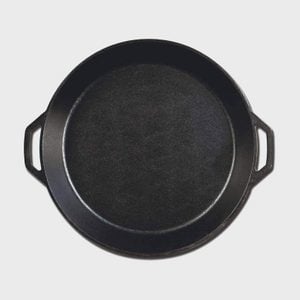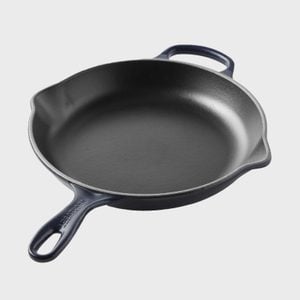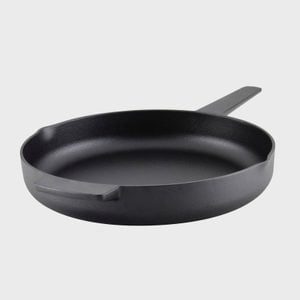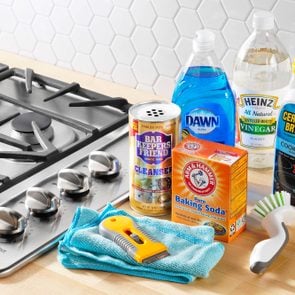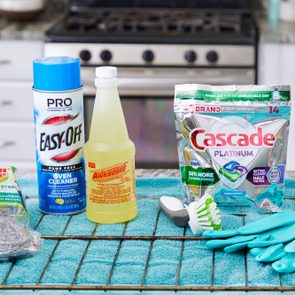How to Clean a Cast-Iron Skillet (Without Destroying It)
Updated: Jun. 02, 2024
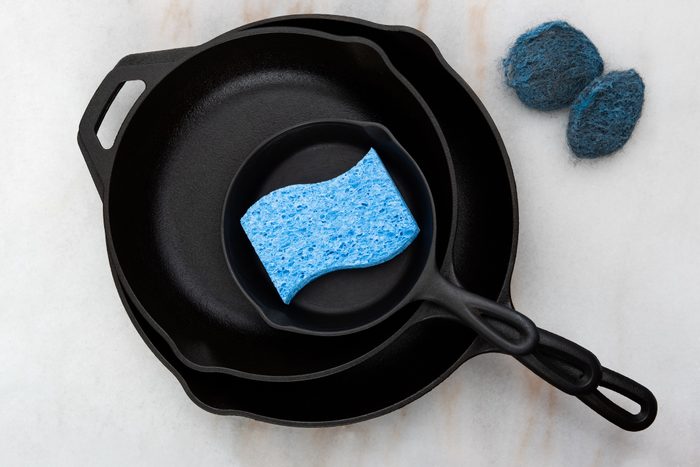
Versatile, durable cast iron cooks beautifully and isn't hard to maintain—no matter what you've heard. Here's how to clean a cast-iron skillet so yours will last for years to come.
Professional and amateur chefs alike love cast-iron skillets. There’s nothing better for putting a sear on a steak or making cornbread that puts your grandma’s recipe to shame. If you’ve never cooked with cast iron, though, you may be a little intimidated. Chances are, you’re also curious why people are so amped up about the cooking tool, whether it’s really nonstick and what it means to season … a skillet? And, of course, you’re no doubt wondering how to clean a cast-iron skillet.
For one thing, you can use cast iron almost anywhere. Throw it on the grill. Slide it into the oven. Fire up the stovetop. Heck, you can even bring it camping and plop it right in the campfire. Cast iron gets better with age too. The more you use it, the more nonstick it becomes. That’s where seasoning—that rich, glossy surface that’s formed when oil and cast iron bond—comes in. And most pans today come pre-seasoned, so you don’t even have to do anything to get started cooking with cast iron.
Whether you’re a seasoned (sorry!) pro or a cast-iron newbie, Kris Stubblefield, a chef at Lodge Cast Iron, has all the expert tips you need to keep your cast-iron skillet cooking for generations to come. After you learn how to clean a cast-iron skillet, come back for more cleaning hacks, like how to clean a burnt pot.
Get Reader’s Digest’s Read Up newsletter for more cleaning, humor, travel, tech and fun facts all week long.
On This Page
Gather your cast iron skillet cleaning supplies
- Dish soap
- Pan scraper or wooden spoon
- Nylon scrub brush or chain mail scrubber
- Cooking oil, such as canola oil
- Paper towels or a lint-free cloth
- Steel wool or rust eraser tool
How to clean a cast-iron skillet after use
A well-maintained cast-iron skillet can last for generations, Stubblefield says, but it’s important to learn how to clean a cast-iron skillet the right way. Luckily, it takes only a few minutes to get yours ready to go back in the cupboard. A few key points here: Never soak your cast-iron skillet in water, and don’t put it in the dishwasher. Both can cause rust, and dishwashing can remove the seasoning. Even allowing a cast-iron skillet to drip-dry after handwashing can leave you with rust spots, so don’t skip the drying step either.
Finally, cast iron is on the list of things you shouldn’t clean with SOS pads, steel wool or abrasive metal scouring pads. Steel wool has its place in restoring cast iron, but it will remove the seasoning—which is not what you want for everyday care.
Step 1: Wash with soap and water
Myth buster No. 1: Stubblefield says it’s perfectly fine to use a little bit of dish soap on your cast-iron skillet, but don’t go overboard. “Using too much soap may remove some of the pan’s seasoning,” he says, “but it can easily be re-seasoned as needed.”
Wait until your cast-iron skillet is cool, then scrub with warm, soapy water and a nylon brush. Rinse well.
Step 2: Remove stubborn, stuck-on food
If you have stuck-on food that doesn’t come off with soap and water, Stubblefield suggests filling the pan with a little water, then simmering it on the stove for about three to five minutes. Allow it to cool, then use the scraper tool to remove the stuck-on grime. (A chain mail scrubber works well here too.)
Next, wash and rinse your cast-iron skillet as described in Step 1.
Step 3: Dry well
Now that your cast-iron skillet is clean, dry it thoroughly with a paper towel or soft microfiber cloth. Don’t skip this step! Leaving even a drop of water in your skillet could cause the cast iron to rust.
Step 4: Oil the skillet
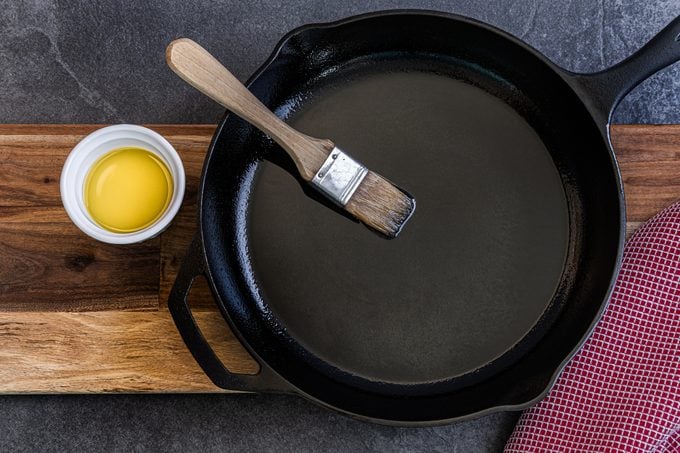
Apply a very thin layer of cooking oil to the entire surface of the skillet using a clean paper towel or cloth. This protective layer shields your cast-iron skillet against moisture and rust. But go lightly—a thin coating is all you need.
How to remove rust from cast iron
Even a well-seasoned cast-iron skillet can get rusty. (After all, it’s made of iron.) That’s why it’s so important to dry your cast-iron skillet every time you wash it.
Life happens, though. Maybe you got distracted and left your skillet to dry on the rack. Perhaps your well-intentioned spouse or partner doesn’t know the first thing about cookware care. Or maybe you found a vintage cast-iron skillet at a garage sale. At some point in time, you’ll need to know how to remove rust from cast iron.
Getting rid of rust is the one time you can safely use steel wool or metal scouring pads on cast iron, Stubblefield says, and that’s only because you’ll be re-seasoning it when you’re done. Here’s how to do it.
Step 1: Scrub
Grab the steel wool or rust eraser tool and start scrubbing. If your cast-iron skillet has just a few rust spots, this might take only a few minutes. For really neglected pans, you could be scrubbing awhile.
Step 2: Wash and dry
Wash your cast-iron skillet with a little bit of soap and warm water. Rinse well, then dry with a paper towel or lint-free cloth. You can also heat your cast-iron skillet on the stove for a few minutes to make sure it’s completely dry.
Step 3: Season
When your cast-iron skillet is dry and free of rust, it’s time to season it to get that gorgeous cooking surface back. Stubblefield walks us through the steps below. You can repeat this step if needed, but each time you cook with fats, the seasoning gets better on its own.
How to season a cast-iron skillet
Knowing how to season a cast-iron skillet is a vital skill for any home chef. Whether you’ve scrubbed that garage-sale find down to bare iron or just removed a few spots of rust, seasoning will get your cast-iron skillet back in top shape—and ready to try out the recipes in this cast-iron cooking guide.
- Wash your cast-iron skillet in warm, soapy water.
- Dry thoroughly with a paper towel or lint-free cloth, or dry on the stove.
- Apply a thin layer of cooking oil to the entire skillet, including the back and sides.
- Turn the skillet upside down, and bake in a 500-degree oven for one hour. (Put some aluminum foil on the rack below.)
- Turn off the oven, and allow the skillet to cool in the oven to complete the curing process.
Pro cleaning tip: You want a very thin layer of oil here—no drips or pools! Too much oil can leave you with uneven, sticky seasoning, and you’ll have to start over.
When to replace your cast-iron skillet
A cast-iron skillet can last for generations if properly cared for. And even if it’s not, there’s no need to throw away yours unless you somehow manage to snap off the handle or otherwise mangle it.
“Unless the cast-iron skillet is cracked or broken,” Stubblefield says, “it’s never too far gone to save.” That’s a far cry from other cookware, which may last only a few years—especially if it gets scratched. (Which is why you should know when to throw away nonstick pans.) Uncover healthy and safe cookware options that will keep your family safe and your meals tasty in every cooking scenario
If you do find yourself in the market for a new cast-iron skillet, check out these great options.
Source:
- Kris Stubblefield, chef at Lodge Cast Iron




















